SintraCascaisSesimbra.com
The best independent guide to the Serra da Arrabida
SintraCascaisSesimbra.com
The best independent guide to the Serra da Arrabida
The Serra da Arrábida and the Parque Natural da Arrábida
Along the southern edge of the Setúbal Peninsula rises the Serra da Arrábida, a magnificent coastal mountain range where lush, forested hills plunge dramatically into the calm waters of the Atlantic. This protected natural park is a region of rugged limestone cliffs, dense Mediterranean vegetation, and picturesque beaches that is easily accessible from Lisbon.
The best way to experience the region is from the Estrada de Escarpa (N379), a spectacular road that winds its way along the mountain ridge, revealing breathtaking views at every turn. From these heights, challenging hiking trails snake through the protected forests, and hidden among the trees is the Convento da Arrábida, a 16th-century Franciscan monastery.
The primary reason most visitors explore the Serra da Arrábida is for its idyllic beaches, known together as the Portinho da Arrábida. Here, the ocean is calm and surprisingly clear, its brilliant turquoise hues lapping against soft, white sands. Backed by the steep, forested slopes of the mountains, these beaches feel a world away from anywhere, offering some of the most beautiful bathing spots in all of Portugal.
The stunning beauty of Serra da Arrábida has remained largely undiscovered by visitors, despite being just a short drive from Lisbon. This guide will provide everything you need to explore the mountains, beaches, and scenic roads of this magnificent coastal park.
Highlights of the Serra da Arrábida
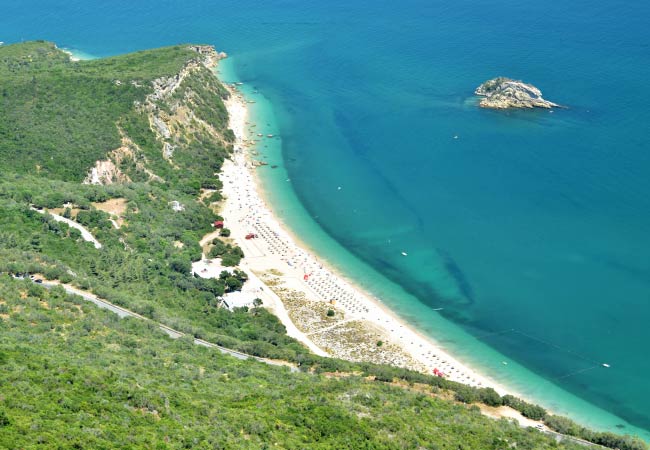
The Beaches of Portinho da Arrábida - A string of idyllic coves where calm, turquoise waters lap against soft white sands. Sheltered by the forested mountains, beaches like Praia de Galapinhos and Praia do Creiro offer some of Portugal’s most stunning and tranquil swimming spots.
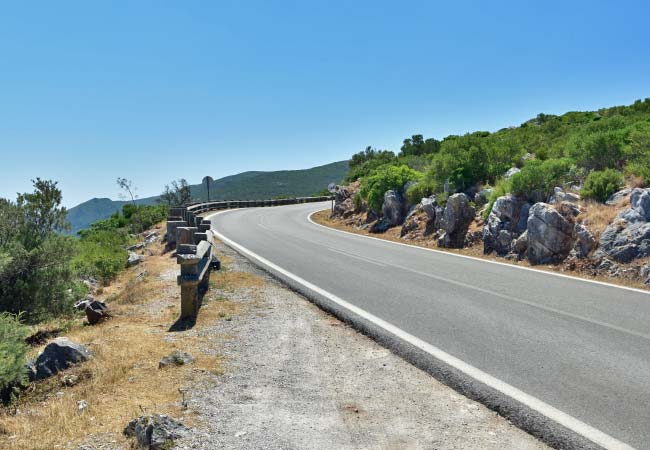
The Estrada de Escarpa Drive (N379) - The spectacular mountain road that snakes along the highest ridge of the Serra. Every turn reveals breathtaking panoramas, and it is deservedly known as one of Portugal's most scenic drives.
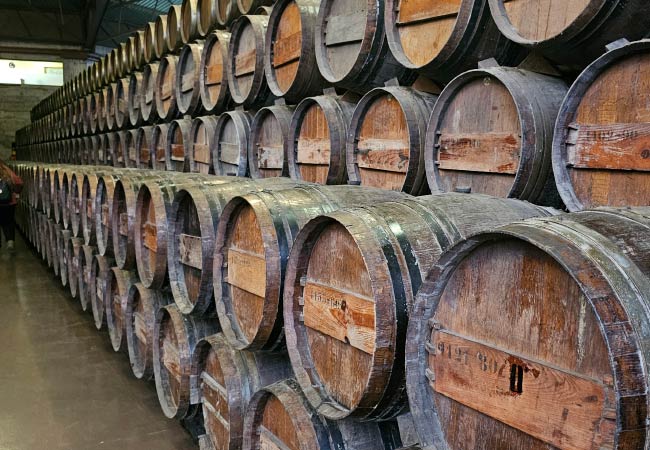
Azeitão Wine Region - The northern slopes of the Serra produce Portugal's famous Moscatel de Setúbal wines. Historic estates like Bacalhôa and traditional quintas dot the vineyards, offering tastings of the celebrated sweet fortified wine alongside the local Queijo de Azeitão sheep's cheese.
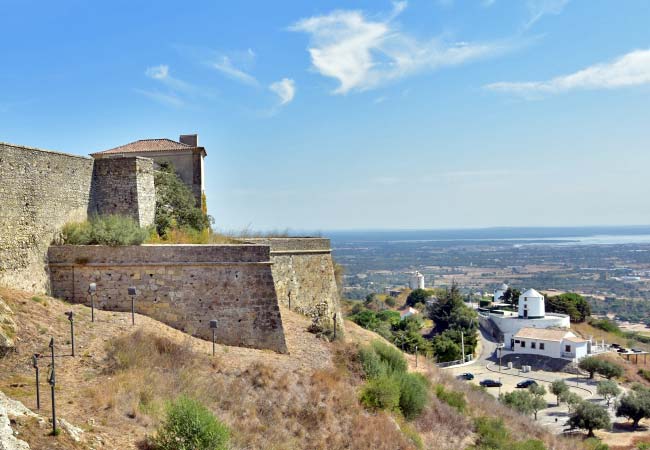
Castelo de Palmela - Standing guard on a towering hilltop at the northern boundary of the Serra. This ancient Moorish castle provides some of the most spectacular views in all of Portugal, with a complete 360-degree vista stretching from Lisbon to the Tagus and Sado river mouths, and across the entire Arrábida mountain range.
The interactive map below shows the highlights of the Serra da Arrábida region. The yellow markers show the beaches, the green points are the regional highlights, and the orange line is the Estrada de Escarpa mountain road.
Highlights: 1) Convento da Arrábida 2) Forte de Santa María da Arrábida 3) Lapa de Santa Margarida 4) Miradouro do Norte viewpoint 5) Portinho da Arrábida viewpoint 6) Serra do Risco 7) Parque de Merendas da Comenda 8) Castelo de Palmela 9) Bacalhôa (winery) 10) José Maria Da Fonseca (winery)
Beaches: 11) Praia do Creiro 12) Praia dos Coelhos13) Praia dos Galapinhos 14) Praia da Figueirinha 15) Praia de Albarquel
Note: The brown shaded area is the Secil-Outão cement works, an ugly industrial area.
The best activities in Arrábida
There are many enjoyable and exciting activities within the Arrábida region, some of the best provided by GetYourGuide include:
• Boat tours to hidden beaches and sea caves - Discover secluded coves and limestone grottoes only accessible from the water, revealing the park's most spectacular coastal formations.
• Coasteering adventures - Combine hiking, climbing, and swimming as you navigate the rugged shoreline, jumping from cliffs into the turquoise waters below.
• Dolphin watching in the Sado Estuary - Join a relaxing boat trip to encounter the resident bottlenose dolphin community that calls these protected waters home.
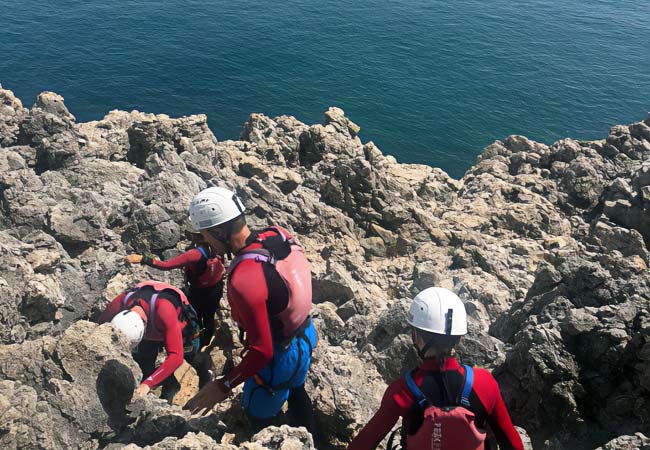
The Parque Natural da Arrábida and the Serra da Arrábida
The Parque Natural da Arrábida embraces two magnificent regions along the southern edge of the Setúbal Peninsula: the dramatic Serra da Arrábida mountain range that rises between Setúbal, Palmela and Sesimbra, and the wild, windswept coastline of Cabo Espichel stretching from Sesimbra to the cape's lonely headland. Created in 1976, this protected sanctuary safeguards an extraordinary Mediterranean landscape where ancient forests meet limestone cliffs, and hidden caves shelter rare wildlife.
The park's domain is vast, covering 176km² split between land and sea. The terrestrial portion spans 123km² of mountainous terrain clothed in dense Mediterranean maquis, wonderfully aromatic thickets of drought-resistant shrubs and twisted oaks that once covered much of southern Europe but have now all but vanished.
Below the waterline, the Professor Luiz Saldanha Marine Park protects 38 kilometres of coastline, where over 1,300 marine species thrive in the crystal-clear waters. Together, they form an unbroken sanctuary that tumbles from the 501-meter summit of Formosinho all the way down to the ocean floor.
For a guide to the Cabo Espichel, please see this article.
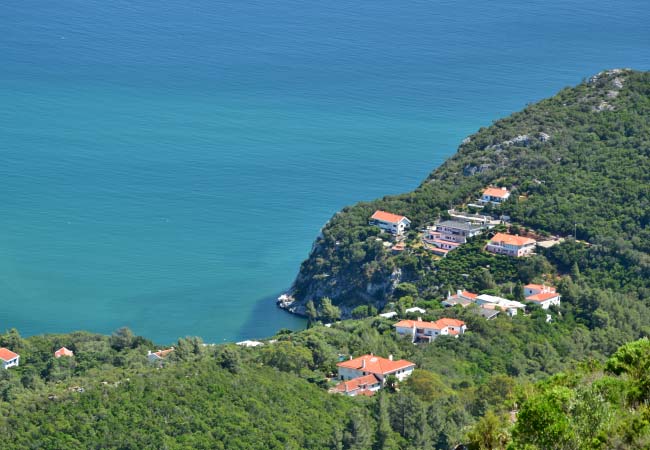
The village of Portinho da Arrábida in the lush forests of the Serra de Arrabida
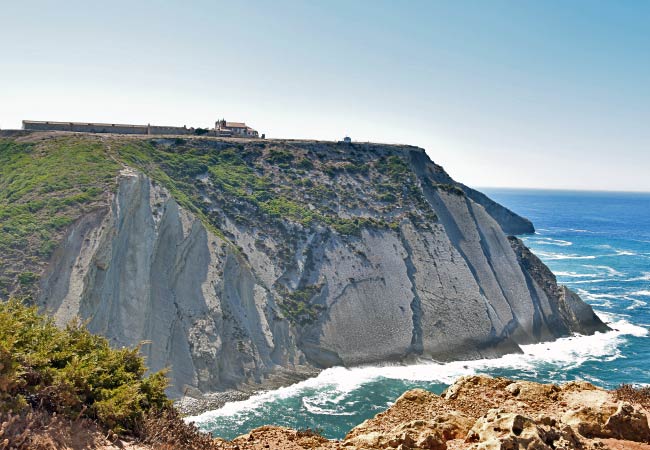
The Cape Espichel is a more barren and windswept coastline than the Serra de Arrabida
Geography and Geology of the Serra de Arrabida region
The Serra da Arrábida mountains were formed during the Jurassic period, when this area was a shallow marine ecosystem. The Late Cretaceous period brought dramatic change through the collision of the African and Eurasian tectonic plates, buckling the Earth's crust and thrusting these ancient seabeds upward to form the mountain chain seen today.
The resulting mountains extend for approximately 35 km in length and 6 km in width, oriented on an east-west axis. Rather than a single ridge, the Serra comprises four distinct ranges: the Serra de São Francisco, the Serra do Louro, Serra da Arrábida, and the Serra do Risco. Each range has its own character and geological story.
The Serra do Risco forms the most southerly chain and has been dramatically eroded by the sea to create sheer cliff faces, including the distinctive Píncaro cliffs that plunge 380 meters to the ocean, the highest sea cliffs on mainland Portugal.
The Serra da Arrábida peaks offer the finest scenery and most challenging hiking, with the region's highest point, Alto do Formosinho (501m) rising as the visible crest of a massive geological fold. From this summit, there is a steep descent of only 1km to reach the sea, creating one of the most dramatic elevation changes in Portugal.
The Serra de São Francisco hills extend along the northern side, where gentle slopes and fertile limestone soils have been cultivated for centuries for growing Muscat grapes. These vineyards produce the region's celebrated Moscatel de Setúbal wines, with the town of Azeitão serving as the center of production.
The Serra do Louro hills to the west, closer to Palmela and Setúbal, offer unspoilt countryside and quieter paths through dense evergreen forests of Ceratonia silique and Kermes Oaks.
The limestone geology has created a classic cave-rich landscape, riddled with over 100 caves, grottoes, and underground cavities.
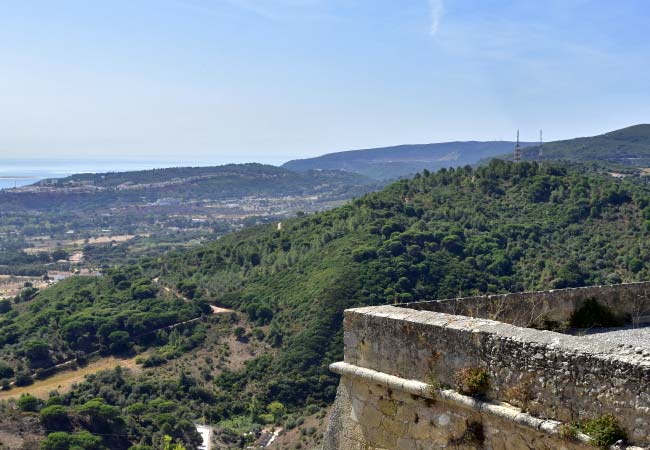
The rolling hills of the Serra do Louro
The Beaches of the Serra da Arrábida
The beaches of the Serra da Arrábida are, for many visitors, the park's main attraction. Tucked into sheltered coves at the base of the lush green mountains, these stretches of fine white sand meet waters of astonishing clarity. The Serra acts as a natural barrier, protecting this coastline from the powerful Atlantic swells and persistent winds that affect the western shores of the Setúbal Peninsula. The result is a series of tranquil bays where calm waters are perfect for families and exceptional for snorkelling.
The coastline offers distinct beach areas, each with its own character. The Portinho da Arrábida cluster includes three of the region's most spectacular coves: Praia dos Galapinhos, Praia do Creiro, and the wild Praia dos Coelhos. Praia dos Galapinhos famously earned the title of "Most Beautiful Beach in Europe" and lives up to this reputation with its postcard-perfect setting where forested hills tumble directly onto golden sand.
Praia do Creiro is larger and combines natural beauty with historical intrigue, sitting adjacent to well-preserved Roman fish-salting ruins. For those seeking true seclusion, Praia dos Coelhos rewards a steep scramble through dense vegetation with an almost completely wild cove, free from any facilities or crowds.
Praia da Figueirinha stands as the largest and most accessible beach in the park. Its wide expanse of sand and shallow, calm waters make it particularly popular with families. Meanwhile, Praia de Albarquel, being closest to Setúbal, serves as the most convenient beach for city residents but can become notably crowded during peak season.
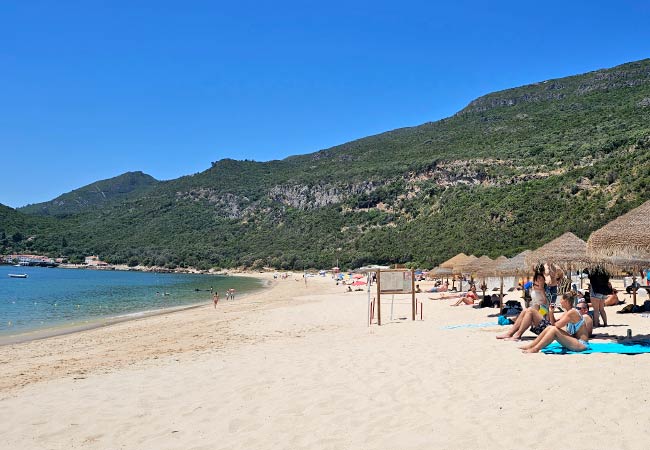
The Praia do Creiro
The Estrada de Escarpa
The N379-1 follows the ancient Estrada de Escarpa mountain path, and is one of the most spectacular and scenic roads in Portugal. This 14km route climbs to nearly 500 meters above sea level, offering a remarkable dual perspective, sweeping Atlantic Ocean views to the south and the park's interior valleys and vineyards to the north.
The road winds up from the Serra do Risco valley in the west, navigates the base of Formosinho summit, crosses the Serra da Arrábida ridge, before dropping down to the coastline at the Parque de Merendas da Comenda. Along the route, you'll pass the Convento da Arrabida and several miradouros (viewpoints) that demand your attention.
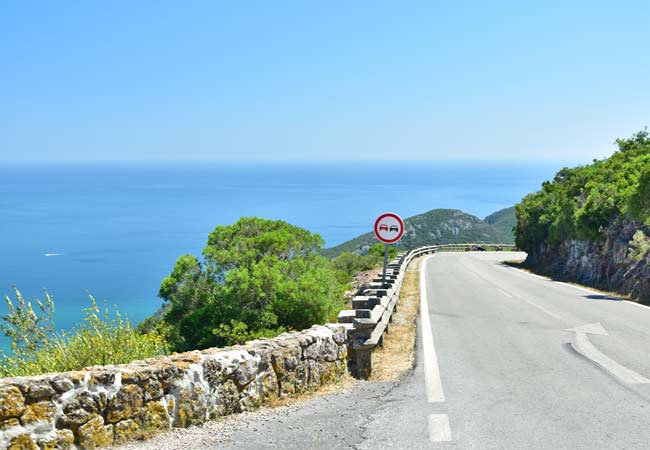
The Estrada de Escarpa as it climbs around the mountains
The Miradouro do Norte remains the standout viewpoint with its contrasting vistas, north over the green valleys towards Palmela Castle and even Lisbon on clear days, and south across the Península de Troia.
The Miradouro do Portinho da Arrábida, perched at the road's highest point, features a wooden platform (a former paragliding launch) that gives you the sensation of floating above the landscape. From here you can spot Portinho da Arrábida beach and Praia do Creiro far below.
The road is safe to drive (two lanes, fully tarmacked with safety barriers) but expect steep inclines and tight twists - this is not a road to rush.
There are a handful of small pull-ins along the route, though you cannot stop on the actual road itself. We'd advise driving slowly and stopping at every opportunity, especially during the busy summer season when parking fills quickly. The Miradouro do Norte has off-road parking for 15 cars, while the Portinho da Arrábida viewpoint can get chaotic at peak times.

The Miradouro Portinho da Arrábida viewpoint
Hiking routes
The Serra da Arrábida is crisscrossed by a network of trails that wind through the dense Mediterranean scrubland. While the main municipalities have been developing signposted routes (Percursos Pedestres or PR trails), many paths remain informal and unmarked.
Alto do Formosinho Summit Trail (PR2) – The park's most challenging and rewarding hike leads to the 501-meter summit, the highest point of the Serra da Arrábida. This strenuous 8.3km linear trail officially begins in Vila Nogueira de Azeitão and concludes on the N379-1 mountain road near Portinho da Arrábida. The ascent from Azeitão is demanding, requiring scrambling over rocky outcrops and navigating steep terrain that borders on mountaineering.
Aldeias de Azeitão (PR4) – This 17km circular route explores the landscape of the northern slopes, starting from Azeitão. The "route" passes through rural hamlets, vineyards and olive groves, offering a gentler alternative that focuses on agricultural heritage rather than coastal drama.
Portinho da Arrábida Coastal Walk (PR3) – An easy 2.3km path connects the village of Portinho to the Praia do Creiro, and passes the Roman ruins and 17th-century Forte de Santa Maria.
The local council of Setubal have created an excellent guide to the routes which can be read or downloaded on the website ‘anyflip’ - anyflip.com/rytry/jvoz/
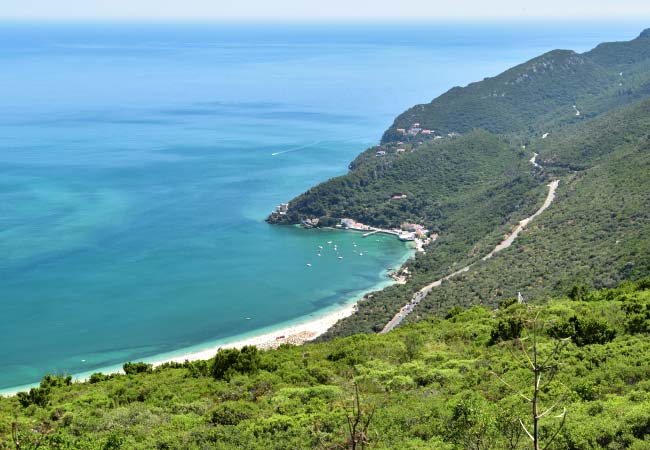
Queijo de Azeitão cheese
Produced in the foothills of the Serra da Arrábida, Queijo de Azeitão is a cheese that embodies the very essence of this landscape. This soft, buttery sheep's milk cheese owes its distinctive character to two unique elements of the Arrábida terroir.
First, the local Merino and Saloia sheep graze on the limestone slopes of the northern Serra, feeding on the aromatic Mediterranean herbs and grasses that flourish in these calcium-rich soils. This specific diet imparts subtle botanical notes to the milk.
Second, the traditional production method uses a vegetable thickening agent (cardoon thistle), which grows wild throughout the park.
This ancient technique, unchanged for centuries, gives the cheese its characteristic tangy sharpness and creamy, almost liquid center when perfectly ripe.
The Parque de Merendas da Comenda
The Parque de Merendas da Comenda is a pleasant area for a picnic or BBQ, and sits at the mouth of the Ribeira da Comenda river with the Sado Estuary. The area provides a sandy river beach, and safe waters for children to splash around in, all under the shade of tall pine trees. There are permanent BBQ pits, for you to cook your own food.
The Convento da Arrabida
The Convento da Arrabida sits halfway up the southern slopes of the serra, its white-washed walls emerging from dense vegetation to become one of the most recognizable landmarks along this coastline. This 16th-century Franciscan monastery sprawls across 25 hectares, not as a single building but as a village of hermits – cells, chapels, and corridors connected by stone pathways and staircases that follow the natural contours of the mountainside.
Founded in 1542 by Frei Martinho de Santa Maria, a Castilian friar seeking profound isolation, the monastery began with just four friars living in cells carved directly from the limestone cliffs. These original rock-hewn hermitages, now called the Convento Velho (Old Convent), still exist at the highest point of the complex. Over the following century, the monastery expanded downward to include the Convento Novo (New Convent) with its main church, refectory and library, plus five distinctive round chapels dedicated to the Mysteries of the Passion.

The architecture reflects Franciscan values of simplicity – fountains and niches are decorated with mosaics made from pebbles, shells, and even broken crockery and colored glass, creating beauty from humble materials. In the hills surrounding the main complex, you'll find additional hermitage chapels where monks could retreat for complete isolation and prayer.
The monastery operated until 1834 when Portugal suppressed all religious orders. After decades of abandonment and decay, the Fundação Oriente acquired the site in 1990 and has carefully restored it as a cultural and spiritual retreat center. Today the convent is privately managed, but guided tours are available if pre-booked in advance: www.foriente.pt/convento-arrabida
The Lapa of Santa Margarida
The Lapa de Santa Margarida is a small 17th-century chapel hidden within a dramatic sea cave near the village of Portinho da Arrábida. This sanctuary embodies the Franciscan tradition of finding the divine in nature's most secluded places.
The chapel is accessed via a steep, winding path of approximately 200 stone steps that descend through the limestone cliffs to reach the grotto at sea level. Inside the natural cavern, which opens directly to the ocean, stands a simple whitewashed chapel complete with a small altar.
Local tradition holds that fishermen would visit the chapel to pray for protection before venturing out to sea, and the site remains a place of pilgrimage, particularly on the saint's feast day.
Public transport in the Serra da Arrabida
The Serra da Arrábida has very poor public transport and is incredibly difficult to explore without the use of a rental car.
There is a bus service from Setubal to Praia da Figueirinha operated by Carris Metropolitana: www.carrismetropolitana.pt
Arrábida Marble
One of the region's most prized geological products is Brecha da Arrábida, often called Arrábida Marble. This distinctive sedimentary rock is a breccia, with angular fragments of older limestone naturally cemented in a reddish clay-carbonate matrix. Formed around 150 million years ago, it was quarried from Roman times through the Baroque era, gracing monuments like the Convent of Jesus in Setúbal.
In recognition of its cultural significance, the International Union of Geological Sciences recently designated it as one of only 32 "World Heritage Stones" globally. With the last quarries closing in the 1970s following the park's creation, this unique stone is now considered an "extinct georesource," its remaining deposits protected within park boundaries.
Our most popular guides to the Sesimbra and Setubal region



























